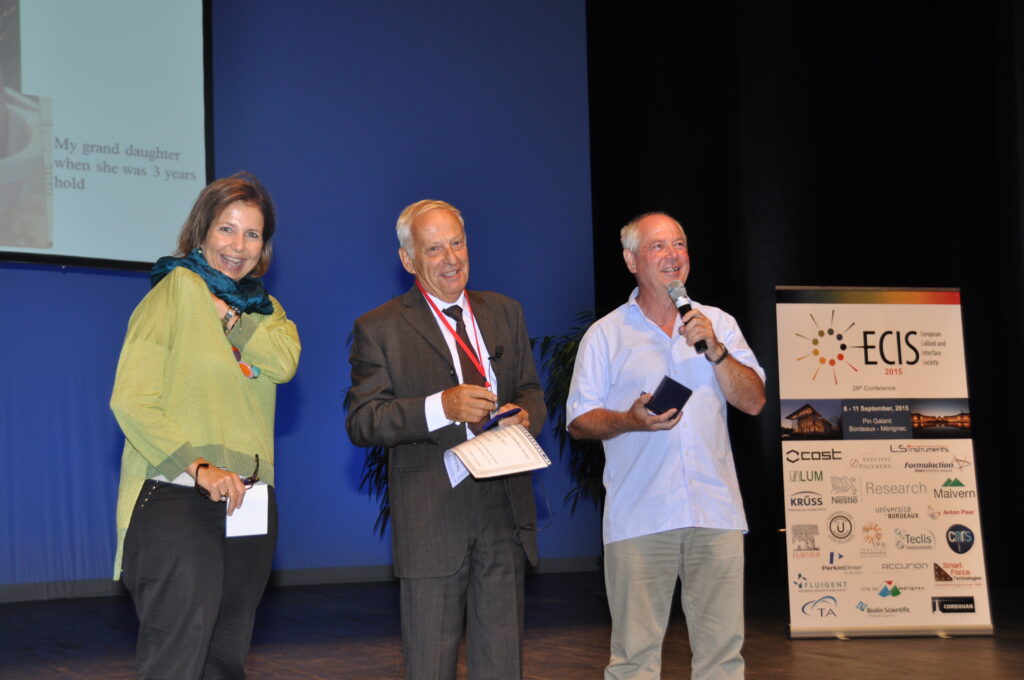
Mario Corti (Milano) center with Deborah Berti and Reinhard Miller
The 2015 Overbeek Gold Medal Winner is Prof. Mario Corti, Milano, Italy. He is awarded the medal for his lifelong fundamental contributions to the development of Colloids and Interface Science.
Mario Corti, born 1940, graduated in Physics at the University of Milano, is an eclectic researcher, outstanding experimentalist and enthusiastic of life and science. He started his scientific career in the field of low energy nuclear physics, working experimentally at the Van de Graaf accelerator. There he got acquainted with fast electronics and to radiation detection techniques, meanwhile cultivating his natural skills in precision mechanics, getting a certification in his spare time while spending one year at the University of Washington in Seattle with a Fulbright Scolarship. Complementary mechanical education contributed to his excellence as an experimentalist.
With the advent of lasers, in 1967 he shifted to Quantum Electronics. He developed fast correlation techniques to measure properties of optical fields and in 1974 he published the paper describing the first fast real-time digital correlator he built himself in conjunction with a still-working laser light scattering apparatus, ensuring high-performance static, dynamic, polarized and depolarized light scattering experiments.
First applications were on pure fluids and binary mixtures, soon turning to colloid suspensions.
In 1975 he published a first paper on non-ionic micelles, followed by a long series of papers on micellar solutions. Used to be at the edge, he obtained major achievements in the field. Among them is the interpretation of the cloud point of non-ionic micellar solutions as the lower critical point of a consolution curve. The discovery of Ising and non-Ising critical exponents for different non-ionic micellar systems has triggered lengthy discussions in the scientific community.
He also pioneered the field of ionic micellar solutions, concerning both the determination of their shape and size near the critical micelle concentration and their role as interesting systems to model interactions in colloidal solutions. The 1981 paper on SDS ionic micelles is a milestone in the literature.
Later on, he turned to biologically relevant amphiphiles, namely glycolipids, entering an interdisciplinary field, nearly unexplored at that time, bridging physics and biochemistry. The use of scattering techniques allowed unravelling the role of glycosidic headgroups in determining the peculiar behaviour of aggregates, micelles, vesicles, mixed systems or liquid crystalline phases. A rich phenomenology was discovered to be connected to the conformational bistability of the huge headgroups of such natural glycolipids, present in the nervous tissues of mammalians, discussed in numerous papers by his team, since mid ’80s, directed both to the colloid and the biochemistry communities.
Again innovative, he recently developped an absolutely new and extremely sensitive experimental interferometric technique to study the properties of gas-liquid or liquid-liquid interfaces operating on a gas bubble or a liquid drop forced to oscillate by an external electric field. Although retired, he is still doing cutting-edge research and technological innovation in this field.
Besides the main stream of fundamental research Mario Corti has put much effort also in the development of technological and industrial instrumentation. For instance, in the eighties, while being responsible of the Laser-Applications Section of the CISE Research Centre, owned by the Italian National Electric Agency, he developed a sophisticated Doppler-velocimeter capable of measuring nanometer-scale-amplitude vibrations of large engineering structures from as far as 200 m away. The instrument, named LADIR, has been extensively used by mechanical engineers to test dams for hydroelectric power generation in the mountains. Recently, he used himself the LADIR to reveal the vibrational modes of the pendant tower of Pisa, with non-invasive detection, then suggesting a putative use of the instrument in the conservation of cultural heritage. He also designed electro-optical instrumentation for clinical use, photometers for ELISA clinical tests, detectors for liquid chromatography, near-infrared-spectroscopy instrumentation. Mario Corti is author of various patents and of 170 papers on international scientific and technological journals.
While working in the CISE Research Centre (1965-1986) he performed teaching activity at the Physics Department of the University of Milan, as Voluntary Assistant, until 1971, and then as Contract Professor, until 1987 when he was appointed Full Professor of Physics at the Faculty of Engineering of the University of Pavia. From 1995 to 2011 (year of retirement) he was Full Professor of Medical Physics, and beloved teacher and mentor for students, at the Faculty of Medicine of the University of Milano.
In 1983, together with Vittorio Degiorgio, Mario Corti organized the XC Course of the Varenna International School “Enrico Fermi” entitled “Physics of Amphiphiles: Micelles, Vesicles and Microemulsions”. This was a pioneering event in the field now called Nanotechnology. Physicists, Physical Chemists, Biochemists and Biologists got together for a couple of weeks with a synergic approach. The Proceedings of the School, edited by V. Degiorgio and M. Corti, were largely appreciated by the scientific community. The ideas born in the Varenna School were developed further in the two Como meetings (again organized by V. Degiorgio and M. Corti) bringing to the convincement that it was the right time for the foundation of an European Society in the colloid field with such new synergic approach.
The 1985 Como meeting was then the founding event of the European Colloid and Interface Society (ECIS). Founders where H. Hoffmann (Germany), P. Bothorel (France), R. Ottewil (U.K.), B. Lindman (Sweden), V. Degiorgio (Italy) and Mario Corti (Italy), who was in charge of organizing the first ECIS meeting, held in Como in 1986. Mario Corti himself tells the story on the ECIS homepage. Mario Corti has been President of ECIS in 1989.
He has been involved in many institutional and scientific panels. Among them, he has been member of the Preparatory Commission of European Community Programme FAST2 on Laser Applications, member of the Scientific Committee of CEA for the Sector of Physical Chemistry of Macromolecules, member of the Editorial Board of “Colloids and Surfaces”, member of the Scientific Committee of the Research Institute on Electromagnetic Waves of CNR, president of the Scientific Committee of the Institute of Spectroscopic Techniques of CNR.
All scientists he met will agree in considering him an amiable man, ready to informal and stimulating exchange on science and life.
